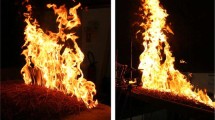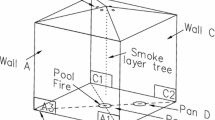Abstract
This paper presents an experimental and numerical study of heat flux and flame heights from fires generated in single burning item (SBI) tests. Thin steel plate probes were developed, as an inexpensive and reliable alternative to heat flux gauges, to measure the surface heat flux, whilst flame heights were determined by analyzing the instantaneous images extracted from the videos of the experiments by a CCD camera. Experimental results obtained at different heat release rates were subsequently used to assess the accuracy of the computational fluid dynamics (CFD) code, Fire dynamics simulator (FDS, V4.07). Simulation results indicated that though predicting reasonably flame heights FDS underpredicts significantly the surface heat flux at higher heat release rates. Consequently, a sensitivity study of the parameters used in the radiation and soot models in FDS was conducted.












Similar content being viewed by others
References
Hasemi Y, Tokunaga T (1984) Some experimental aspects of turbulent diffusion flames and buoyant plumes from fire sources against a wall out in a corner of walls. Combust Sci Technol 4:15–26
Kokkala MA (1993) Characteristics of a flame in an open corner of walls. In: Proceedings of Interflam, Interscience Communication Limited, London
Heskestad G (1995) Fire plumes. In: DiNenno PJ (ed) SPFE handbook of fire protection engineering, 2nd edn., National Fire Protection Association, Quincy
Cheng Q (1995) Turbulent flame spread on vertical corner walls. National Institute of Standards and Technology, NIST-GCR-95-669
Dillon SE (1998) Analysis of the ISO 9705 room/corner test: simulations, correlations and heat flux measurements. National Institute of Standards and Technology, NIST-GCR-98-756
Ohlemiller TJ (2000) Estimating Fire Growth on Composite Materials in a Corner Configuration. In: 45th International SAMPE symposium and exhibition, vol 45. Long Beach, CA, pp. 1229–1243
Lattimer BY, Sorathia U (2003) Thermal characteristics of fires in a non-combustible corner. Fire Saf J 38:709–745. doi: 10.1016/S0379-7112(03)00065-1
BRITISH STANDARD BS EN 13823:(2002) Reaction to fire tests for building products—building products excluding floorings exposed to the thermal attack by a single burning item
Lennon PF, Silcock GWH (2001) An investigation of the ability of a thin plate heat flux device to determine the incident heat fluxes during enclosure fires. Int J Eng Performance-Based Codes 3:1–15
Tofilo P (2006) Factors controlling the behaviour of glazing systems in enclosures. PhD dissertation, University of Ulster
Audouin L, Kolb G, Torero JL, Most JM (1995) Average centreline temperatures of a buoyant pool fire obtained by image processing of video recordings Fire Saf J 24:167–187. doi:10.1016/0379-7112(95)00021-K
McGrattan K, Forney G (2005) Fire dynamics simulator (version 4) user’s guide. NIST Special Publication 1019, National Institute of Standards and Technology, Gaithersburg
Zukoski EE, Kubota T, Cetegen BM (1981) Air entrainment in fire plumes. Fire Saf J 3:107–121. doi:10.1016/0379-7112(81)90037-0
Floyd J, Lattimer BY (2003) Validation of FDS V4 boundary heat flux predictions for a corner fire. In: Proceedings of Interflam, Edinburgh
Lautenberger CW, de Ris J, Dembsey NA, Barnett JR, Baum HR (2005) A simplified model for soot formation and oxidation in CFD simulation of non-premixed hydrocarbon flames. Fire Saf J 40:141–176. doi:10.1016/j.firesaf.2004.10.002
Beji T, Zhang J, Delichatsios MA (2008) Determination of soot formation rate from laminar smoke point measurements. Combust Sci Technol 180:927–940. doi:10.1080/00102200801894398
Delichatsios MA (1994) A Phenomenological Model for Smoke-Point and Soot Formation in Laminar Flames. Combust. Sci. Technol. 100:283–298. doi:10.1080/00102209408935457
Smyth KC (1999) Diffusion flame measurements of species concentrations, soot concentrations, temperature, and velocity. Available online at http://www.fire.nist.gov/fire/flamedata/
Acknowledgements
The authors acknowledge the EU for financially supporting the PREDFIRE-NANO project under Grant number 013998 in the sixth Framework Program. The authors thank Mr M. McKee and Mr W. Veighey for helping with the experiments.
Author information
Authors and Affiliations
Corresponding author
Rights and permissions
About this article
Cite this article
Zhang, J., Delichatsios, M. & Colobert, M. Assessment of Fire Dynamics Simulator for Heat Flux and Flame Heights Predictions from Fires in SBI Tests. Fire Technol 46, 291–306 (2010). https://doi.org/10.1007/s10694-008-0072-6
Received:
Accepted:
Published:
Issue Date:
DOI: https://doi.org/10.1007/s10694-008-0072-6




